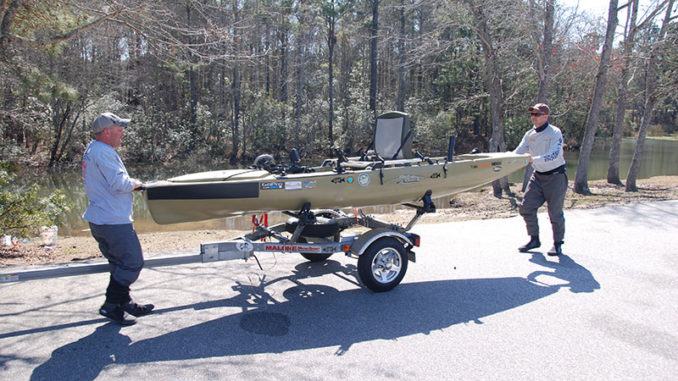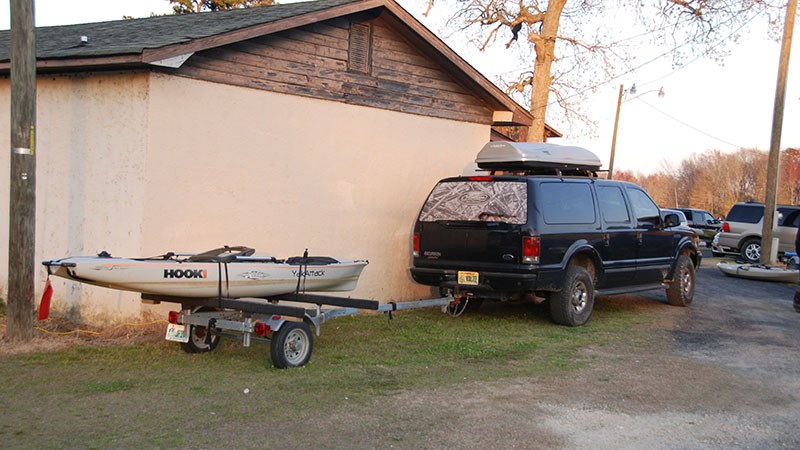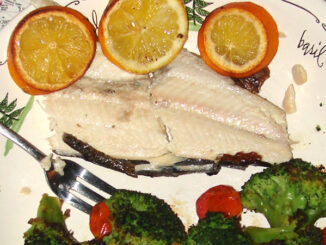
Kayak anglers often brag about the ability to get quietly into backwaters that few other anglers can reach. Getting to remote or isolated areas on the water is a simple practice for paddlers. But sometimes it’s getting from Point A – Home, to Point B – Water’s Edge, that’s the problem.
In its most simplistic terms, you throw the ‘yak in the bed of a pickup truck, along with a paddle and go. Logistics become a little more difficult when there’s “stuff” attached to the top of the boat, stuff that took a long time to get properly situated, and rolling the boat over on its side or upside down presents a problem.
If you intend to truly car-top a kayak to your chosen fishing area, then it’s best to start with some type of rack system that is designed for the automobile you’ll be driving. Some auto manufacturers have stock racks that are of suitable design and strength to support a kayak. But it’s still best to augment those devices with some type of padding. Pads can be commercially produced models or something homemade.
The other option is to go with a system made specifically for kayak transport. Companies like Yakima, Thule, and Malone all make excellent cartopping systems that will secure your boat for highway use. Some models may even allow for tandem carrying of kayaks.
The individual manufacturer will provide the model or adaptors needed to fit your specific year, make and model automobile and how to install it on your vehicle. One safety precaution to keep in mind is that highway travel will cause the straps and clamps that these systems employ to loosen. So check them at frequent intervals during your journey. Also remember to replace any worn parts.
Not to say that cartop systems can’t be used in conjunction with a light truck, but many kayak anglers choose to use a bed rack system as the roof of most light trucks is smaller than some SUVs or automobiles. You can find a broad list of manufacturers who offer kayak specific truck racks on the web or customize a standard utility rack to meet your boat’s needs.
Another note about car or truck topping is to factor in both the weight of the boat and the semi-permanently attached gear that goes with the boat and will be supported by the rack. Also, consider if you’re going to load the boat by yourself or have help getting it on top of the vehicle.

Best Bets
NORTH CAROLINA
WHAT — Redfish and Trout
WHERE — New River and New River Inlet
HOW — Throw hard topwater baits early and late, then fish scented, saltwater plastics that mimic shrimp or mullet through the day.
LAUNCH — Several private marinas sit on both sides of the New River and countless dump-ins are suitable for a kayak launch. Public access can be found at https://www.ncwildlife.org/boating/where-to-boat
INSIDER TIP — Reds may be spooky until water temperatures reach the 70-degree mark. Poling into position and presenting free-lined baits with no popping cork works for both lethargic and pressured redfish and trout.
SOUTH CAROLINA
WHAT — Sharks, redfish, and bottom fish
WHERE — Southern Coast Inlets from Charleston to Hilton Head
HOW — Anchor or drift using large pieces of cut whiting, mullet, or other fresh fish. For bottom fish, use frozen squid on a fish finder rig.
LAUNCH — Some inlets on the southern coast around James Island, Kiawah, Edisto, and Fripp Islands have beach access where you can launch in slack water, paddle into or through the inlet, and fish nearshore sandbars.
INSIDER TIP — Plan your launch with the tide cycle. It’s much easier to paddle out on an outgoing tide, then come back in on the incoming.
How ‘bout a trailer?
Some years ago, it sort of flew in the face of many kayakers to transport their watercraft on a trailer. The thought was that defeated the purpose of getting to and parking anywhere a moderately successful 2- or 4-wheel drive vehicle could go and be relatively unobtrusive.
Fact is, you may prevent yourself from using some waterside dump-in sites if you choose to trailer your boat and that should factor into the decision-making process. You don’t have to back the trailer into the water like you would a power boat to launch, but you’re still going to need room to park the whole rig when you’re off fishing.
On the plus side of trailering, multiple boats can be hauled on a single trailer which provides a good measure of safety, especially if you’re hauling the boat long distance. Another plus is with some ingenuity, you can customize the trailer with boxes or tubes to hold rods, tackle, and gear, saving space for passengers in the vehicle.





Be the first to comment